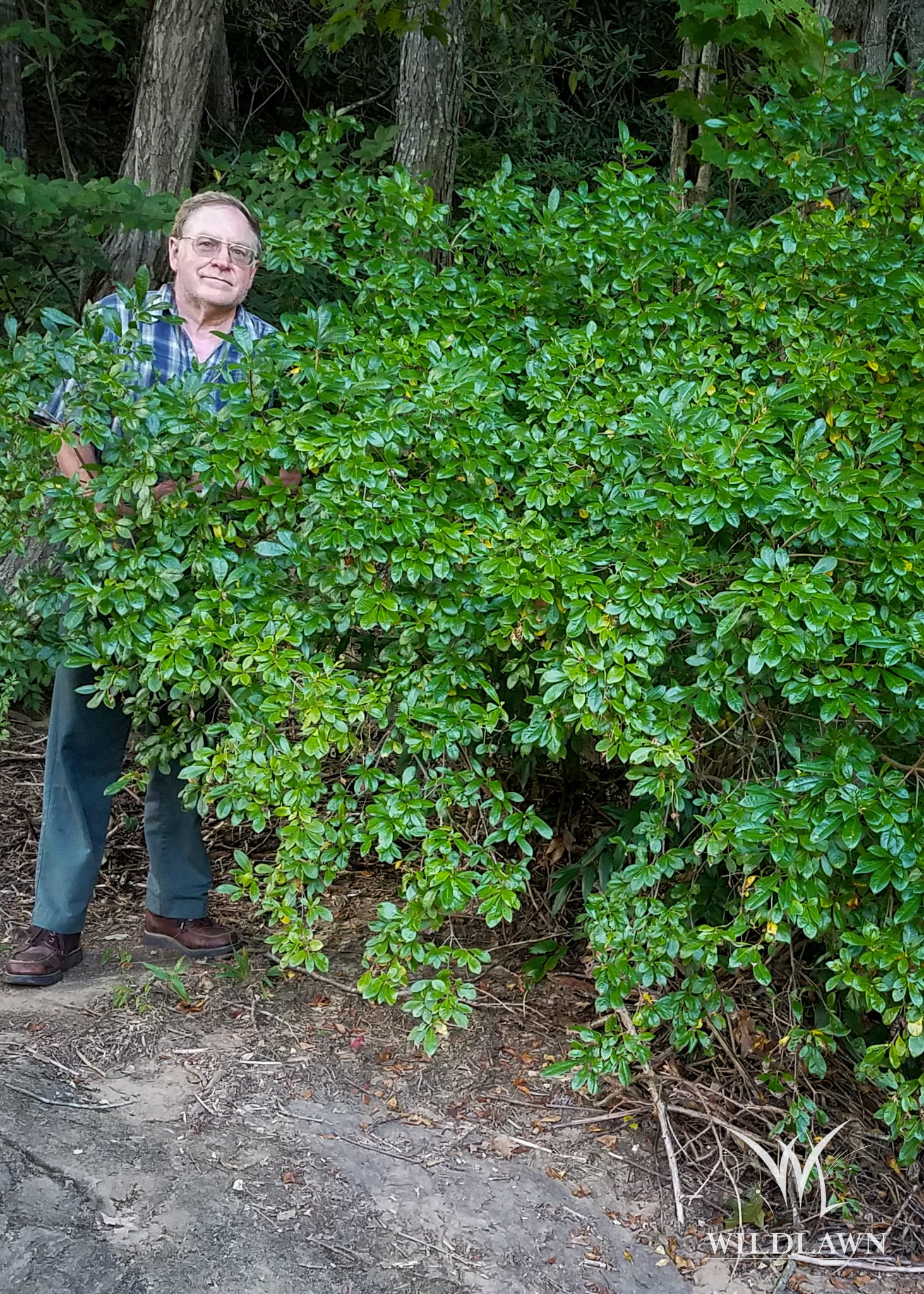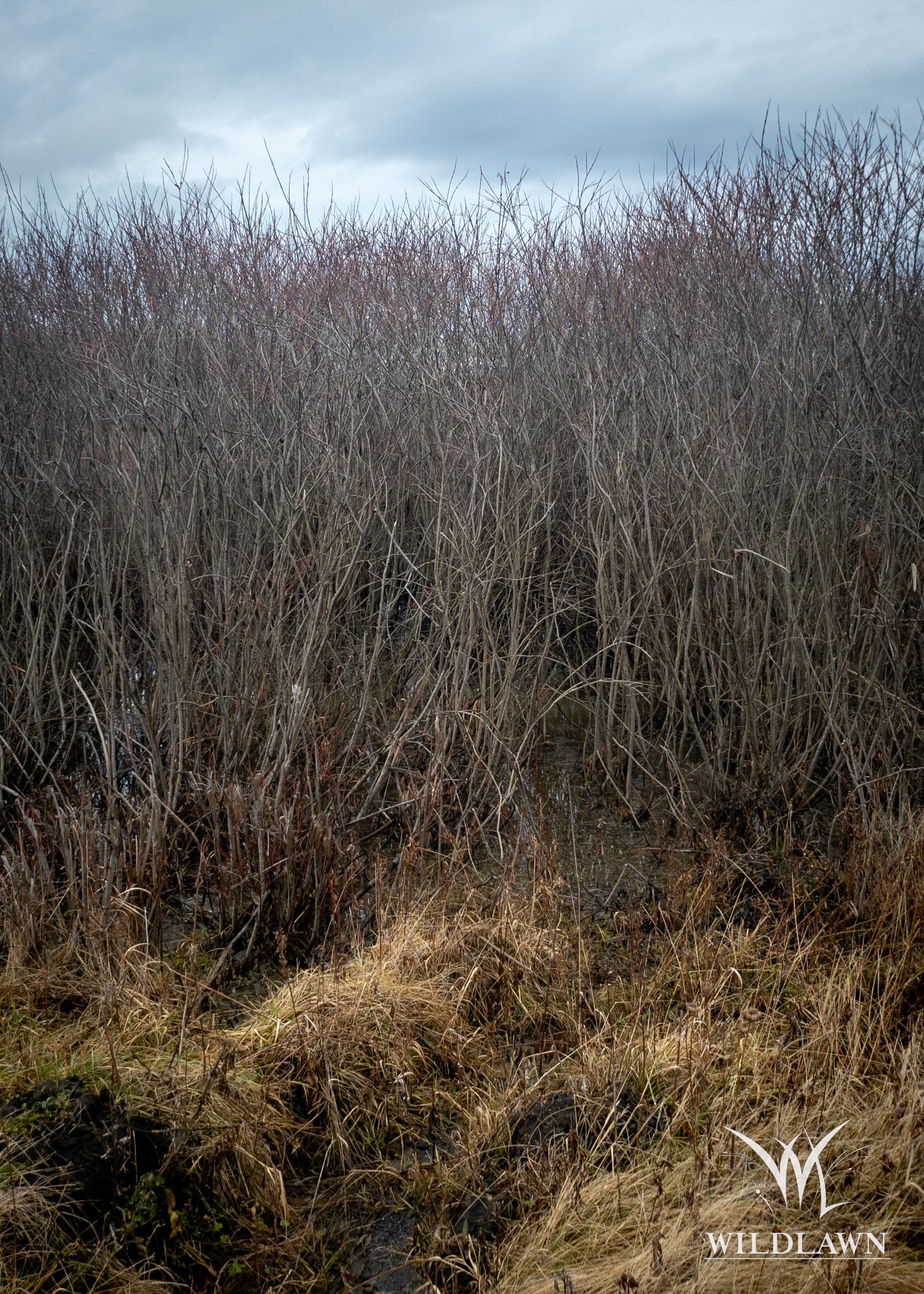
WildLawn Guide to Native Hedgerows and Bird Habitats
Hedgerows are historic yet they are needed now more than ever.
Hedgerows were first constructed during the Bronze Age and have played a significant role in protecting local ecologies ever since. Intentional Roman-built hedgerows still exist in England and are protected by law. Hedgerows host myriad bird and beneficial insect species, reduce soil erosion, and act as nurseries for vulnerable plant species. An excellent graphic depicting the history of hedgerows, right up into the 21st century can be seen here (ptes.org).
Native hedgerows are difficult to establish because most species have narrow soil and moisture requirements and require deer and rabbit protection during establishment. Native hedgerow species must be carefully matched to site conditions so that they grow, together, harmoniously.
Browse our collection of hedgerow types below to get a sense for what might work best for you.
Do Birds Really Need Native Plants?
Birds, particularly those that consume insects during part of their life stage, need native shrubs and other natives.
Birds are twice as likely to be found in predominantly native plantings vs. those that only have a few.
Plus, native plantings support double the number of bird species.
Native plants produce large quantities of small seeds, which small songbirds consume, hence, the not quite doubled overall biomass of birds (956 vs 636).
This tall hedgerow of Hypericum densiflorum performs best in full sun and consistently moist soils. Here, two WildLawn staff on a seed-scouting trip stopped to admire the incredible number of blooms. Can grow to 8’ tall in optimum conditions.
Choosing Native Hedgerow Species
This section profiles some of our favorite hedgerow species. Not all species suitable for hedgerows are listed.
Cornus drummondi is one of WildLawn staff’s favorite hedgerow species. Suitable for mesic and poor soils, it can reach to 12’ tall and produces enormous amounts of fruit that birds ravish. Numerous bird nests are found each winter tucked away inside the dense branching. Rhizomatous, so can create thick hedges all on its own.
This native azalea (Rhododendron arborescens) can attain a height of over 8’ tall in mesic, organic, sandy soils, particularly if north-facing. Copious pink-white blooms in spring. Must be protected from saturated soil conditions. Most Rhododendron should not be eaten.
Physocarpus opulifolius is an all-around outstanding hedgerow and bird habitat species. Often featuring large white and sometimes pinkish flowers in spring and orange fruit capsules at the right time in the fall. The dense branching allows for many bird nests. Requires full sun and adequate soil moisture to perform well as a hedgerow. It looks best along ditches or other locations with a steady supply of moisture. No need to buy cultivars of this species. The wild plant does simply fine on its own.
Salix sericea is widely used amongst restorationists for its rapid growth, handsome structure, and for its outstanding wildlife value. Fed upon by a wide range of insects and mammals, silky willow can transform a wet meadow into a wildlife haven quickly and inexpensively. An instant hedgerow becomes possible in saturated soils and along ditches. A common site in upstate Pennsylvania, lower New York, and higher elevations in West Virginia.
More commonly known as fragrant sumac, Rhus aromatica can grow to 8’ tall in well-draining soils. Not to be confused with the hybrid cultivar “low-gro’, this native shrub forms a tough, durable, wild-looking hedgerow. Well-sited in full sun, birds and people can enjoy the deep orange to red fruits that show off every few years. Tolerant of low nutrient soils, this hedgerow and bird habitat species works well where so many others cannot.
Mixed and Matched Hedgerows
This native hedgerow features an array of species that all enjoy the same growing condition. Note how the hedgerow promotes the recruitment of an herbaceous layer, some of them rare. Although this looks like a wild hedgerow, it is the result of WildLawn staff creating an upland shrub bird habitat on a farm in New York.
Edible Hedgerows
This dense hedgerow was created as a native food forest and features mostly shrubs with fruit that can be eaten directly, if you beat the birds. Amelanchier laevis, Amelanchier arobora, Vaccinium corymbosum, Viburnum nudum var. cassinoides, Viburnum prunifolium, Prunus virginiana, and others create a beautiful, functional, and delicious hedgerow.
Special attention is required to soil composition and soil moisture conditions for this type of hedgerow to work. Consult a WildLawn specialist before attempting on your own.
One of the more unusual hedgerows can be created using Quercus prinoides, which naturally inhabits inland sand plains and pine barrens. Capable of growing in any well-draining soils, it does require some protection from larger trees shading it out, such as red oak. This scrub oak produces a fair amount of fruit but not every year. However, being in the white oak group, it supports a dizzying array of insects, which makes this species an ideal bird habitat as well as a hedgerow. Can be incorporated along with other smaller hedgerow species.
Bamboo hedgerows
Bamboo can provide excellent screening but is virtually useless as habitat for birds or anything else. Can quickly grow out of control and choke out everything in its path. Very expensive to remediate.
So unless you have a pet panda, we suggest exploring one of the other hedgerow types described herein.
Diervilla sessilifolia can form the nearly perfect suburban-type hedgerow. Topping out at about 4-5’ feet, hummingbirds and bumblebees regularly visit the yellow and orange tubular flowers.
The fruits are small and aren’t a major food source. Deer can sometimes browse the tips but rarely consume the entire plant.
Highly rhizomatous, this native honeysuckle is exceptionally durable when planted in a well-made bed or in any moist soil other than clay. Can be sheared, pruned, or doted over as much as any traditional hedgerow species without negative effect.
Even landscape architects that haven’t yet learned about native plants will use this highly efficient species to demarcate trails and paths.
A must-try plant, in our opinion.
One of the most beautiful hedgerows and bird habitats can be created using Aronia melanocarpa, or one of the other chokeberries. The fruits aren’t particularly valuable to birds except as a last resort so they are more useful to people as an antioxidant. Gorgeous form, flowers, fall color, and dark berries. Chokeberries must have reliable moisture to grow properly and are often associated with near wetland-like conditions. Full sun is a requirement.
Caution: many nurseries are selling a Siberian hybrid of black chokeberry as our native black chokeberry. Try sourcing from a reputable restoration nursery, like ArcheWild.
Bear oak
An extremely rewarding, but also challenging, hedgerow and bird habitat can be created using Quercus ilicifolia. Absolutely dominant in its core range, it can survive drought, fire, brush-hogging, and any other destructive natural force. A reliable and copious fruit producer, bear oak feeds more wildlife than any other plant in its range.
But before you rush out to buy these great dwarf oak trees (they can grow to 8’ or more), we recommend checking with a WildLawn specialist to see if you have the proper habitat type. Bear oak has very specific soil moisture requirements, which can sometimes be provided through extensive soil manipulation.
If you are looking for challenge, and a huge reward, consider working bear oak into your bird habitat or hedgerow plans.
Morella pensylvanica is one of those amazing shrubs that we just cannot get enough of. Extremely useful for well-draining, low nutrient soils, even sometimes mixed clay, and gravel. Forms dense hedgerows in its core habitat, which is tertiary sand dunes.
Cedar waxwing and other birds capable of dehusking the fruit swarm this hedgerow species. 1000s of birds can be found amongst the bayberry at the right time in the fall.
Avoid buying the dwarfed cultivars, which cannot reach the full stature of this native shrub, which is about 8’ tall. Some 12-15’ tall trees can be found on remote beaches on Long Island.
Not all hedgerows need to be woody; this trailside hedge features Symphyotrichum prenanthoides and little bit of Monarda didyma. The edges of the trail feature deep organic soil that holds enough moisture to allow these rhizomatous species to create a dense hedgerow and provide an excellent habitat for pollinating insects and small birds.
Viburnum nudum var. cassinoides, or sometimes Viburnum cassinoides, is a favorite amongst WildLawn staff. Easy to grow in moist soils, it shares amazing colors and forms all year long. Early buds and leaves are deep copper color until the broad, creamy white flowers emerge. In summer, it’s just green. But in the fall, the deep orange to red foliage is amazing, along with the white to pink to red to black fruit set.
Easily combined with black chokeberry and common winterberry to create a multi-textured hedgerow and bird habitat.
And, yes, the dried fruits taste just like raisins and are a fun snack for the intrepid seed collector.
Mixed Species Hedgerow
This hedgerow used to grace Stuyvesant Cove Park in New York City and provided a much-needed sanctuary for small songbirds. It also provides a sense of sanctuary for park-goers. A taller herbaceous hedgerow in the foreground contributes to the dense, wild aesthetic.
Species include Baccharis halimifolia and Rhus aromatica, both growing in an organic, sandy soil.
Winterberry holly, or Ilex verticillata, is one of the more reliable hedgerow types. Although they are home to swamps, fens, and marshes, they can often grow simply fine elsewhere. Winterberry holly seeds will not germinate outside of their core habitat, but the shrubs can persist in the landscape for decades. Bright red fall fruits are occasionally eaten by migrating songbirds, mostly American robins in our area. Yellow to orange fall foliage with interesting branching structure. Very slowly rhizomatous.
Garden centers often sell matched sets of cultivars; be sure to buy a few males to go along with your females.
Another herbaceous hedgerow type can be created with Eutrochium fistulosum, or any of the other joepye species. Each joepye has slightly different siting requirements and they are rarely found together in the wild so check with a WildLawn specialist before choosing. Hollow-stemmed joepye is the tallest, reaching up to 12’ or more in optimal conditions. Highly durable in consistently moist, but not saturated, soils.
Not so much a bird habitat but a butterfly feeding station. If you have butterflies anywhere nearby, we promise that they will find these plants.
Easily planted in dual or triple rows to create a dense flowering hedge during the growing season. Stems can be knocked down and removed after Thanksgiving. Both easy, and dramatic.
Ubiquitous anywhere with well-draining soils such as in shale-based soils and sand plains, Juniperus virginiana var. virginiana is the only viable native evergreen hedgerow and bird habitat species.
Excellent form and color all year, as long as they are in full sun. Summertime color can range from a deep piney-green to a seafoam green (rare). They can darken in the fall to a rusty red. In good years, the fruit set is unbelievable and can appear dark blue in many cases.
A perfect bird habitat shrub or small tree. Well-sited specimens can become quite tall, however, so plant with caution. An alternate host for apple-cedar rust, so avoid using if you have Amelanchier nearby.
Spiraea tomentosa is an excellent low-growing flowering shrub for consistently moist soils in full sun. Found at the edges of marshes and seeps, there are few more beautiful sights in the wild.
Densely growing and rhizomatous, these shrubs top out about 4’ and create habitat for ground-dwelling birds that forage in the safety they provide.
Again, consistently moist soil and full sun are absolute requirements. If sited well, they will persist for decades without intervention. Deer rarely browse spiraea.
Mixed Moist Soil Hedgerow
Moist soils can support a wide range of shrubs that can happily coexist, with a little bit of management from time to time.
Shown here are species that prefer consistently moist soils and includes: Ribes Americanum, Cornus sericea, Hypericum densiflorum, Frangula caroliniana, Salix caroliniana, Aronia melanocarpa, Betula uber, Viburnum nudum var. cassinoides, Ilex decidua, and others.
This particular hedgerow implementation doubles as a botanical garden. Birds hang out in this hedgerow all year long, or at least until the food runs out.
If you’ve been looking for a challenge, Ptelea trifoliata could be your hedgerow. One of our few native citrus’ this glorious shrub makes more a thick, aromatic shrub that forms dense colonies and sports white fruit disks in the fall.
Although technically a widespread shrub, it has extremely specific siting requirements. Core habitat is often considered freshwater dunes but can be found throughout the east along rivers and in the Appalachian Mountains. Achieving the correct soil moisture and texture is the key to successfully using this species for a hedgerow. Used more by insects that feed birds than as a food source for birds themselves.
Alnus serrulata is another widely used species for rapidly creating bird habitat in moist soils. Found growing along the margins of ponds and marshes or along mountain streams in full sun. Intolerant of inundation or saturated soils.
A similar species, speckled alder (Alnus incana ssp. rugosa), is capable of growing in the water and can often be found nearby smooth alder in cooler climates.
Both Alnus species support a wide range of insect species, which feeds birds, and their enormous seed crop feeds small seed-eating birds throughout the winter.
Shore Black Cherry
You are a well-travelled botanist if you know this species, which has yet to be fully recognized by science. This is a rhizomatous black cherry tree that grows no more than about 10’ tall. It produces an unbelievable number of flowers and fruit; groves of this species are absolute wildlife magnets. Pollinators swarm the flowers in spring, insects gorge on the leaves in the summer, and birds need not travel anywhere else to satisfy their hunger.
Rarely found in production, there are few nurseries that occasionally carry this species, which is sometimes called Prunus serotina ssp. littorale (which means black cherry growing near the shore).
An article on Facebook briefly mentions this species.



























